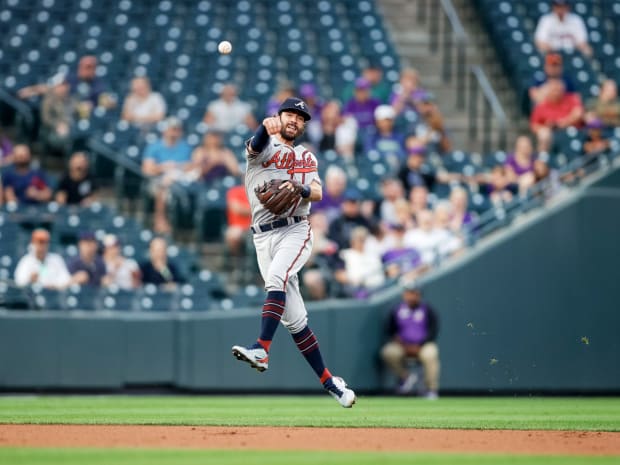It is not just launch angle and the love of the home run that has changed hitting. Infielders are better than ever.
Something strange happened on the night the Braves won the pennant last year, though it does fall in line with how the Braves became world champions, how the Yankees’ new hitting coach wants to win the next World Series and why baseball has changed drastically.
The Braves sent 40 batters to the plate against the Dodgers in NLCS Game 6. Only one of them made an out on the ground. They are the only team with just one grounder for an out in the 446 playoff games since 2010.

Isaiah J. Downing/USA TODAY Sports
The Braves were The Greatest Show Above Earth. Their path to the title was paved by hitting fewer ground balls than any team last season. They chased home runs, and the strategy worked. Naturally, the Braves won the NLCS clincher because of a home run: a two-out, two-strike, three-run blast by Eddie Rosario off a Walker Buehler cutter.
Home runs also decided the World Series. Atlanta won the World Series because it out-homered Houston, 11–2. The Braves scored 17 of their 25 runs on home runs.
With a .244 average, the Braves were the worst hitting world championship team since the DH was added in 1973. It didn’t matter. This is how you win in the information age: get the ball in the air.
The ground ball is dead.
Dillon Lawson, the new Yankees hitting coach, provided his own eulogy for the grounder when he met the media over Zoom this week.
“So, all we’re saying is we want to hit line drives,” Lawson said, “and if we happen to miss, we would rather miss in the air than on the ground, especially how elite defenses are now, their positioning, their skill level, arm strength … all of those things. It’s tough now.”
Sign up to get the Five-Tool Newsletter in your inbox every week during the MLB offseason.
In other words, it is not just launch angle and the love of the home run that has changed hitting. It’s what has happened to defenses. Infielders never have played as deep as they do today. It is because of improved arm strength; faster, immaculately groomed infields; and the dying threat of bunts. Deeper infields equal more range, and more range equals fewer hits. Throw in finely tuned shifts and good luck trying to hit a grounder through the infield.
Every infield position is playing deeper than it did five years ago:
Average Depth by Position (RH Batter, No Shift or Runners on Base)
What does more depth mean? More hits taken away and more reason for hitters to hit the ball in the air. Ground ball hits have declined 13% in five years:
MLB Ground Balls
That’s 5,996 fewer ground balls and 1,865 fewer hits on the ground in five years. It is a recent trend. Look at this chart: ground balls per season since 2008 (not including the shortened '20 season). You can see how ground balls fell off a cliff starting in '16:

With so many fewer ground balls, infield defense becomes less important—and just as people like to get deep into the weeds with defensive metrics. This may well be the golden age of shortstops, but they are asked to defend less than any of their predecessors.
Let’s take a quick snapshot of how the job has changed. Here are the chances per game of four Hall of Fame shortstops from different eras and of Carlos Correa, who last season was judged to be the best defensive shortstop in the majors:
Way back in another era, 2015 to be exact, the Royals won a world championship with a ground-ball-oriented offense. They ranked eighth in most ground balls and sixth in ground ball hits. That cannot happen today.
Last season, only one of the eight teams who hit the most ground balls made the playoffs (White Sox). Meanwhile, seven of the 11 teams who hit the fewest made the playoffs.
The batting average on balls in play in each of the past two seasons is .292. You must go back to 1992 to find a time when it was harder to get a hit on a ball in play. The search to get more balls airborne also leads to easier outs. Batted balls in play in the air that are not line drives produce a .098 batting average.
So why hit more balls in the air? The home run. It’s worth the risk. The reason why Lawson and all hitting coaches preach line drives and prefer the “misses” to be on the higher end of the launch angle spectrum is found here in the slugging column:
2021 MLB Batting by Trajectory
Nothing drives the game today more than the home run. From 2014 to '21, the rate of runs scored on home runs jumped from 33% to 47%. The two teams that relied the most on home runs won the most regular-season games (Giants, 53.5%) and the World Series (Braves, 52.4%). Seven of the 10 teams with the most home runs made the playoffs. None of the 10 teams with the fewest home runs made the playoffs.
The modern hitting coach has learned that slug is a better predictor of success than batting average. If that truth wasn’t already obvious, infielders that play deeper and infielders with more athleticism and arm strength are driving home the point: death to ground balls.
More MLB Coverage:
• Spring Training Is Unlikely to Begin on Time
• WAR Is Not the Solution for Baseball’s Labor Woes
• The Infield of Active Players Closest to the Cooperstown Cut Line
• The Outfield of Active Players Closest to the Cooperstown Cut Line
• The Active Pitchers and DHs Closest to the Cooperstown Cut Line